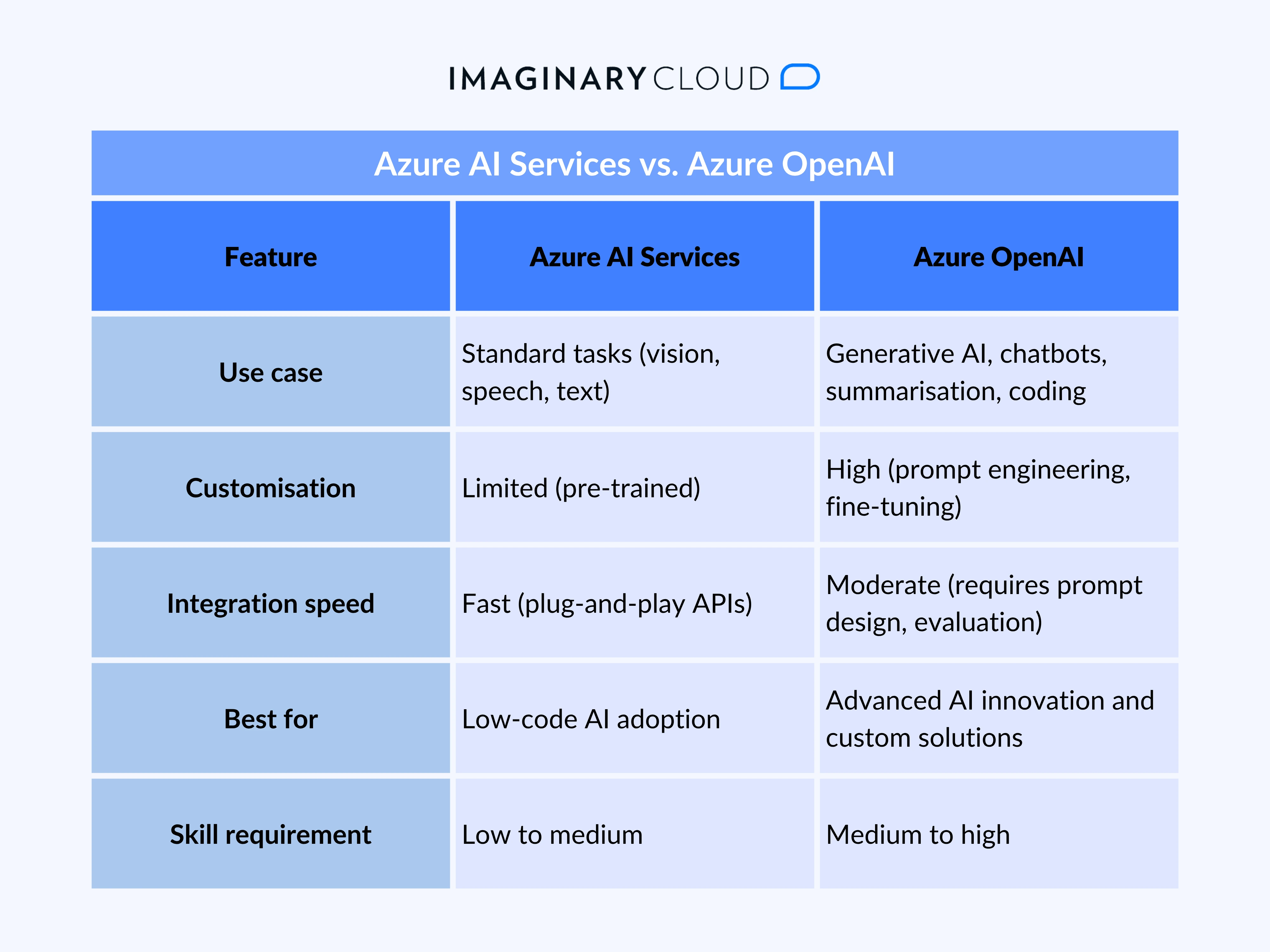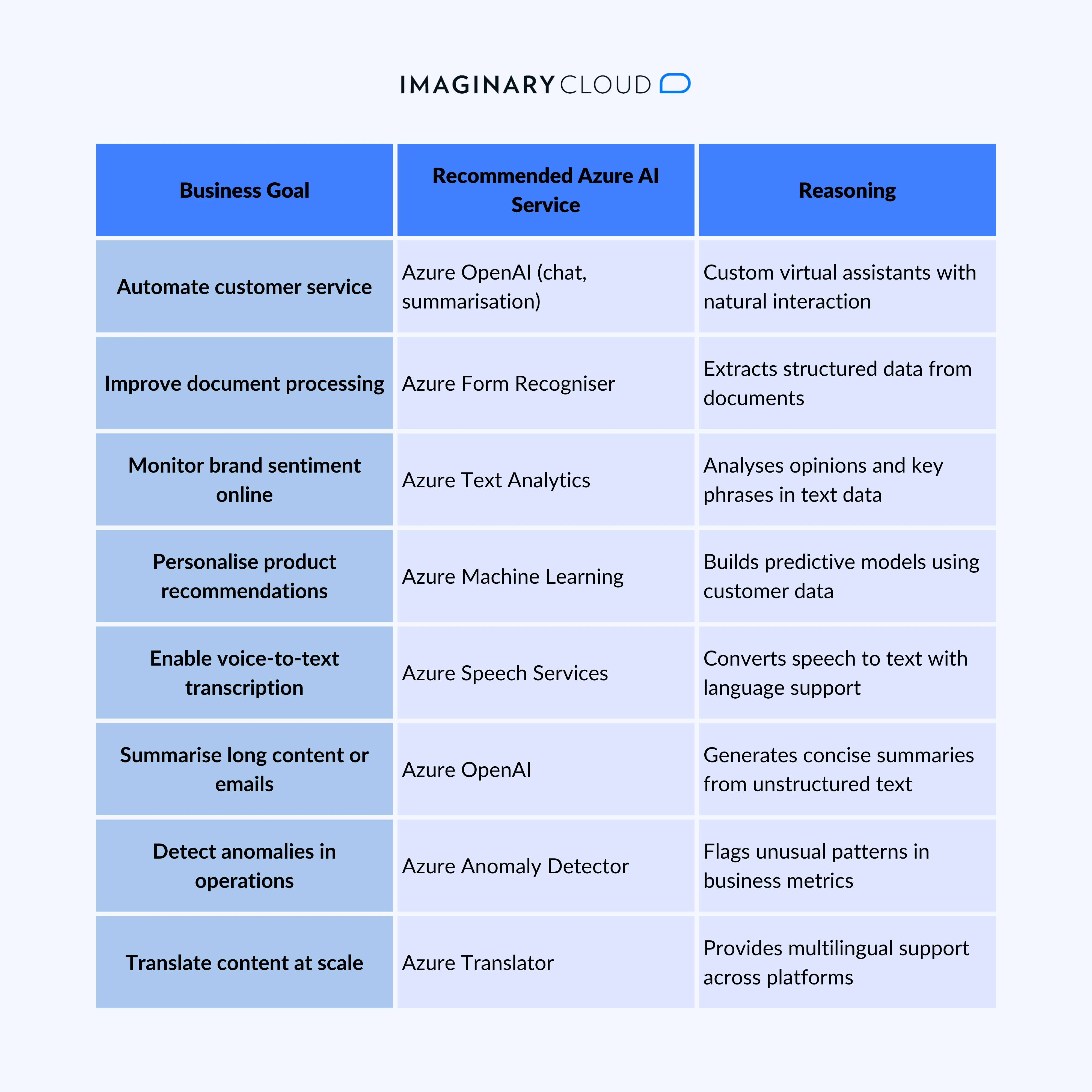contact us


Azure AI services are a suite of cloud-based tools from Microsoft designed to help organisations build, deploy and scale artificial intelligence solutions. These services support a wide range of use cases, from machine learning to natural language processing, and are tailored for business innovation, growth and operational efficiency.
Key features of Azure AI services:
Organisations across industries are increasingly turning to artificial intelligence to drive innovation, automate processes, and improve decision-making. Azure AI services provide the tools needed to embed intelligent capabilities into everyday business operations, enabling both technical teams and decision-makers to unlock measurable value.
Microsoft’s AI ecosystem aligns directly with modern strategic priorities, such as:
By integrating Azure AI into their digital strategy, businesses can move beyond experimentation to real transformation.
Selecting the most suitable Azure AI service depends on your organisation’s goals, data maturity and technical capabilities. Microsoft offers a range of purpose-built tools designed for varying levels of expertise and different types of business challenges.
Azure AI Services are pre-trained models that provide out-of-the-box functionality for everyday tasks such as speech recognition, image analysis and language translation. They are ideal for rapid deployment and minimal coding.
Azure OpenAI offers access to advanced generative models like GPT, allowing businesses to build custom applications powered by natural language understanding and generation. This option is better suited for organisations seeking more flexibility, creativity or domain-specific use cases.
Key differences:

Use this guide to identify which Azure AI service aligns with specific business goals:

Quick Take: Choosing the Right Azure AI Model
Once you have identified the Azure AI services that align with your business goals, the next step is to plan and execute a successful integration. Whether you are introducing ML solutions to streamline operations or deploying generative models for customer engagement, a structured approach ensures measurable business impact.
Begin by aligning AI initiatives with strategic objectives and measurable outcomes. This includes identifying departments that will benefit most from automation, personalisation, or enhanced decision-making.
Key steps:
Tip: Start with one high-impact use case (e.g. automating document processing) to validate value before scaling.
With a defined objective, use Microsoft’s prebuilt APIs or custom model deployment pipelines through Azure Machine Learning. Pilot programmes should be small, controlled, and iterative.
Recommended practices:
Tools to explore:
Deployment is only the beginning. To maximise operational efficiency and long-term growth, Azure AI solutions must be monitored, optimised, and governed.
Ongoing tasks:
Key metrics to track:
In Summary: How to Implement Azure AI Successfully
.webp)
Azure AI services are actively transforming businesses across sectors, from retail and manufacturing to financial services and insurance. These are not speculative pilots; they are live, measurable implementations driving operational efficiency, innovation and business impact at scale.
UK supermarket giant Sainsbury’s entered a multi-year strategic partnership with Microsoft to embed AI and machine learning throughout its operations. From shelf-edge cameras to generative AI tools that improve in-store restocking and online search experiences, Azure AI plays a central role in their digital transformation. The initiative supports the company’s target to save £1 billion in structural costs by 2027.
TAL, one of Australia’s leading life insurers, implemented Azure OpenAI Service and Microsoft 365 Copilot to automate the summarisation of complex insurance policies and client documents. Employees now save up to six hours per week, freeing up time for more value-driven tasks and improving the speed of customer response.
Companies such as Epiroc are using Azure AI and machine learning to monitor equipment performance, predict maintenance needs and reduce production downtime. With Azure’s ability to integrate sensor data via IoT and apply real-time anomaly detection, these manufacturers report greater operational visibility and product consistency.
SymphonyAI, a Microsoft partner, built Sensa Copilot using Azure AI to help banks detect financial fraud in real time. The solution combines machine learning with domain-specific intelligence to analyse large volumes of transactions. Financial institutions using this tool have reported faster time to insight and enhanced risk management capabilities.
While Azure AI services offer powerful tools for innovation and operational efficiency, many organisations face setbacks due to poor implementation planning or misaligned expectations. Avoiding these common mistakes can ensure a smoother path to measurable business impact.
Too often, businesses deploy AI models without a clear link to strategic priorities. This leads to underutilised tools or solutions that solve the wrong problems.
Avoid this by:
AI adoption is not just a technical project; it changes how teams work, make decisions and serve customers. Without proper change management, even the best models can face resistance or be abandoned.
Common mistakes:
Best practices:
Not all Azure AI services are equal in scope or function. Using the wrong model, for example, applying Azure OpenAI for basic sentiment analysis, can increase costs, delay results and reduce accuracy.
To avoid this:
AI systems must be transparent, secure and aligned with industry regulations. Failure to account for data privacy, bias mitigation or governance frameworks can lead to reputational and legal risk.
Recommendations:
Build compliance into early project phases, not after deployment.
The opportunity to transform your business with Azure AI services is no longer theoretical. It is practical, proven, and already delivering impact across industries. Whether you are looking to automate document workflows, enhance customer experiences, or drive predictive insights, Azure offers a scalable foundation for innovation and measurable growth. But success with AI is not just about choosing the right tools. It’s about aligning technology with strategy, people and purpose.
Ready to take the next step? Let’s explore how Azure AI can solve your business challenges and deliver tangible results.
Contact us today to discuss your goals and request a tailored consultation. We’re here to help you build smarter, faster and with confidence.
Azure AI services are a set of cloud-based tools from Microsoft that allow businesses to build, deploy and manage artificial intelligence solutions. They include prebuilt APIs (like vision, speech and language), custom machine learning tools, and access to generative AI models such as GPT through Azure OpenAI.
No, Azure AI is a platform, while ChatGPT is a specific application powered by OpenAI’s GPT models. Through the Azure OpenAI Service, businesses can access the same underlying models as ChatGPT but customise them for their own use cases, such as chatbots, content generation or data summarisation.
Some Azure AI services offer free tiers, including limited usage of Cognitive Services or model training. However, most enterprise-grade use requires a paid Azure subscription, with pricing based on consumption, model complexity and deployment type.
No, but they are related. Copilot refers to AI-powered features embedded in Microsoft 365 apps (like Word, Excel and Outlook), many of which use models hosted via Azure AI infrastructure. Azure AI provides the foundation, while Copilot delivers a packaged experience for productivity users.
Start by identifying the business goal (e.g. automation, prediction, language tasks). Use Azure AI Services for common tasks, Azure OpenAI for generative AI, and Azure Machine Learning for building custom models.
Yes. Azure AI services are built to scale across global operations. They support high-availability infrastructure, robust security, and enterprise-grade governance, making them suitable for large-scale implementations.
The best model depends on your data, complexity and use case. For basic automation, Azure AI Services may suffice. For deeper control or innovation, Azure OpenAI or Azure Machine Learning are more appropriate.
Yes. Many Azure AI services, including Azure AI Services and low-code options within Azure AI Studio, are designed for business users and developers without deep AI expertise.
Azure OpenAI meets Microsoft’s enterprise compliance standards, including security, privacy and responsible AI governance. Usage can be monitored and governed via Azure's built-in tools.
Azure AI offers deep integration with Microsoft products, global scalability, and enterprise security. While other platforms like AWS or Google AI offer similar tools, Azure excels in productivity and compliance environments.


Alexandra Mendes is a Senior Growth Specialist at Imaginary Cloud with 3+ years of experience writing about software development, AI, and digital transformation. After completing a frontend development course, Alexandra picked up some hands-on coding skills and now works closely with technical teams. Passionate about how new technologies shape business and society, Alexandra enjoys turning complex topics into clear, helpful content for decision-makers.
People who read this post, also found these interesting: